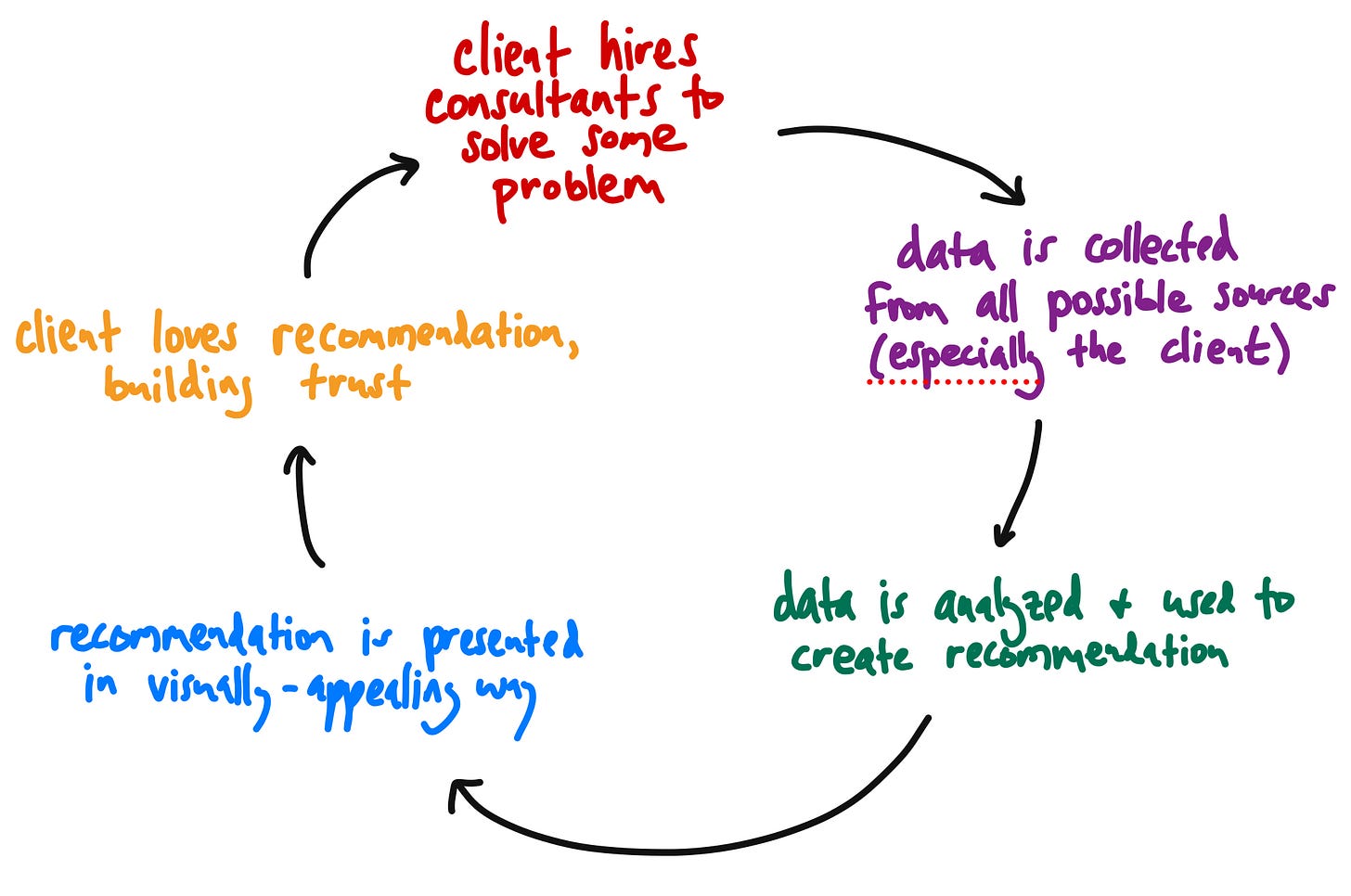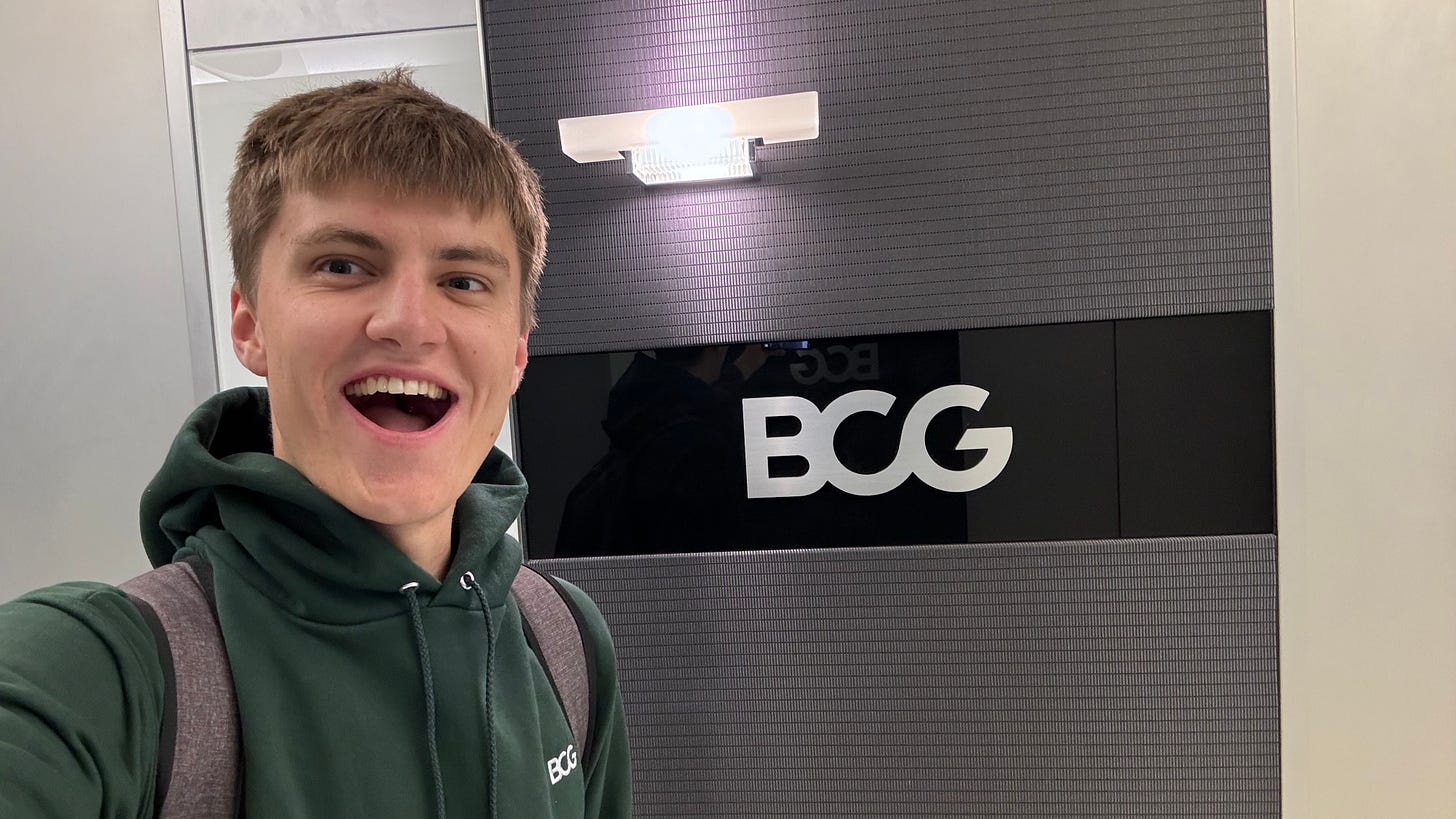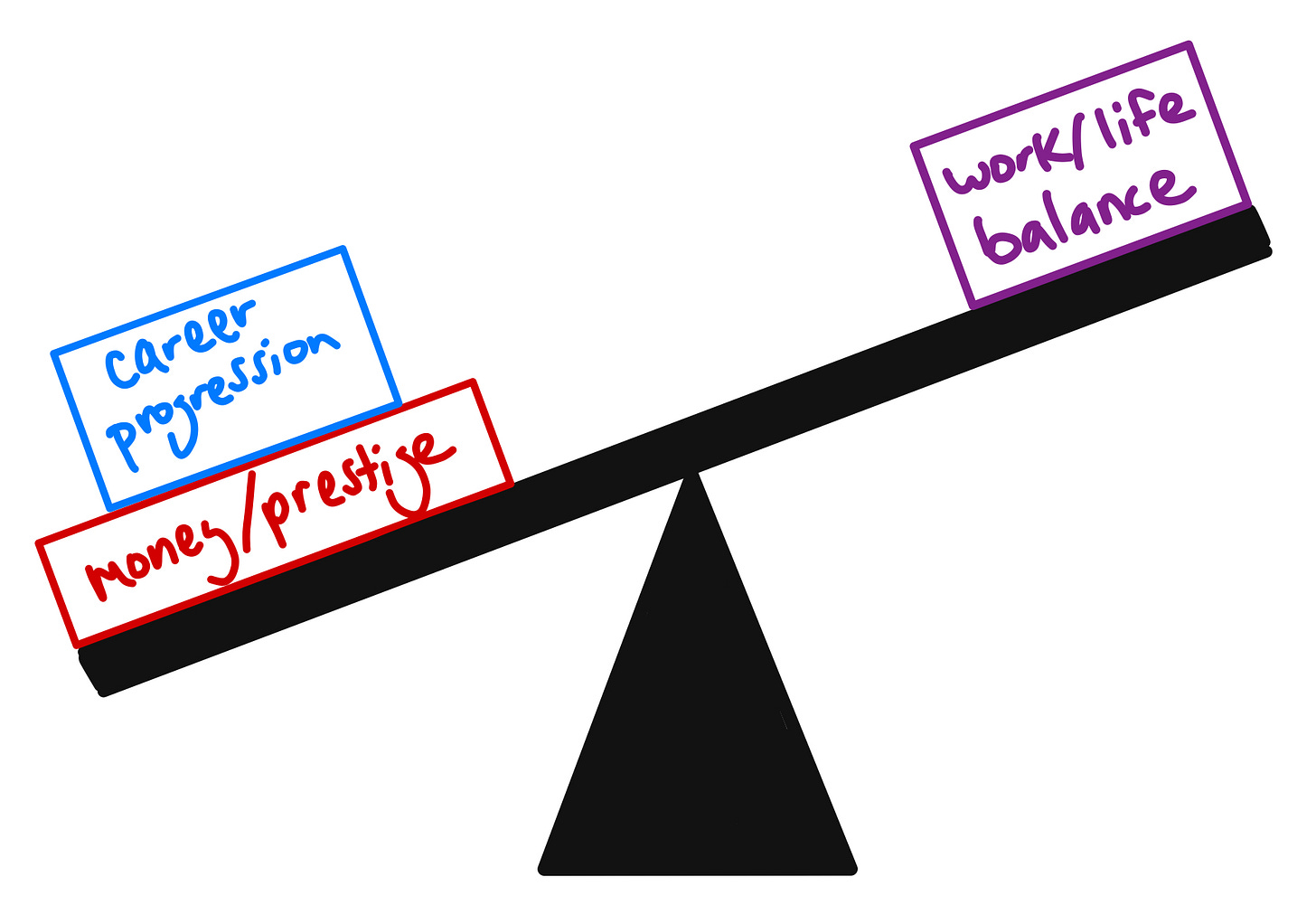This article was first published in August 2024 and has been edited for clarity since then.
The most common question that I’ve heard regarding consulting is, “Well, what does a consultant actually do?”
I myself have asked this question many times, both before and during my consulting internship at BCG. What in the world does a consultant spend all day doing?
Fortunately, there are plenty of people and online sources to help us out (like the ones here and here and here and here).
They say something like this:
“Consultants solve client’s hardest problems”
“They’re doctors for businesses”
“They sit in meetings all day and make PowerPoint slides look pretty”
So on and so forth.
The problem with all of these responses is that they were given by students who hadn’t actually worked in consulting (and just repeated the prevailing wisdom of others), consultants/recruiters during networking calls (that naturally paint rosier views of their companies), or outsiders that have no relation to the consulting world at all.
All previous responses I’ve read or heard have answered parts of the question, but always left me wondering more. I was very excited to start my consulting internship in small part because I’d finally find out. This essay here is my attempt to share what I’ve found.
We’ll fully answer the question of what consultants do in four main sections:
How it works
The pros
The cons
Thoughts on the general nature of work
Let’s get started!
How it works
At the very highest level, a consulting firm is hired to solve some problem(s) for a client. These problems were so hard that the client couldn’t solve them themselves, so they looked to outside help for guidance.
These problems can be about anything. Some may be related to restructuring the company, potentially after a recent merger or acquisition (this may involve moving around departments, altering its board, or even moving headquarters). Other problems may be about deciding what market to enter, product to build, or initiatives to start/cut. Sometimes, a company may need some help pricing their products and services.
Basically, any imaginable problem a company might have.
The key thing is that this problem was so challenging that the client wasn’t able to handle this problem, so they outsourced it to a consulting firm with an impartial outside view.
This may have been because the client doesn’t have the expertise or technical know-how to solve the problem (it’s usually cheaper to hire a consulting company than to hire full-time staff). There may be a disagreement between different stakeholders in the client’s company. Or they want to have a third party mediate (e.g. a division needs to be cut, but the company isn’t sure which one).
Most importantly, a client might hire a consulting company for their expertise in certain industries and practice areas. The consulting companies have done plenty of projects in those areas before, and their teams quickly customize a solution that’s tremendously beneficial. A client might have no idea how to digitize their pricing strategy, but the consulting team has done several projects just like it that year and uses its relevant expertise to help the client out.
Consulting companies are well-known for making a ton of money, and they do so through the brilliant cycle shown below:
Once a consulting firm secures a project, the data collection begins from any and all possible sources. The client is usually a huge data source themselves, providing any data relevant to the project (sales metrics, staff headcounts, financials, board minutes, etc.). Experts are interviewed. The team will likely reach out to previous project leaders at the consulting firm who have done similar projects before for advice, tips, and findings (during my summer project, my team chatted with a Mexico City-based team about their similar project and what they found).
And a lot of Googling is done to find as much publically available data as possible. At BCG, this is known as “desk research”.
This data is analyzed (in Excel) to determine what the client should do, and a recommendation is presented (in PowerPoint) based on that data.
The client loves the recommendation, trusts the consulting firm more, and hires them for more projects in the future. More projects mean even more client data for the consulting firm to analyze, making them more desirable for future clients since the firms with the most (and best) typically provide better recommendations.
This cycle also explains the corporate hierarchy at consulting firms. At the bottom are the “individual contributors” (“ICs”) that do all the data collection and analysis. At the top are the partners who present findings and recommendations, foster client relationships, and most importantly, sell business (get more projects for the consulting firm).
And in the middle are the project leaders that run the day-to-day, making sure the project is running smoothly. They direct the ICs in the right direction and keep the partners up-to-date on the project (the partners work on several cases at a time and aren’t involved in the nitty-gritty data collection and analysis on each case).
In terms of day-to-day work, the four things that a consultant does are collect data through “desk research” (Googling) and expert interviews, aggregate and analyze data in Excel, make slides in PowerPoint, and participate in meetings on Zoom or in person (the exact breakdown of these activities depends on the project and day). The more senior you are, the more meetings you have.
At BCG, the individual contributors are the As (Associates, hired from undergrad) and Cs (Consultants, hired as experienced hires or from business school). Middle managers are the PLs (Project Leaders) and Principals. Partners are the Partners, MDPs (Managing Directors/Partners), and MDSPs (Managing Directors/Senior Partners). All consulting firms have a hierarchy similar to this one with slightly different titles.
The pros
There are a ton of benefits to working as a consultant.
The industry pays very well, with salaries well over 6-figures right out of college. The jobs are very prestigious (just based on the number of LinkedIn connection requests I receive) and the lifestyle is very glamorous. The offices are very fancy, the office snacks are delicious, flights are first-class, hotels are 5 stars, and all food is free while traveling. It was quite the new experience for me!
You also get the privilege to work with some extremely smart colleagues on some very interesting projects. Your teammates are smart and driven, the clients are well-known companies with brilliant businesspeople themselves, and you work with senior executives who would otherwise be far out of reach. The comradery between a team is immense, and my teammates quickly became the folks I interacted with the most each day.
Every week during my summer internship, I’d hear about all the different projects happening at BCG and was blown away each time. Entry-level consultants were working directly with CEOs of Fortune 100 companies.
In these kinds of environments, you get to learn how the top companies in the world are run by working with their top businesspeople. You learn extremely quickly (so-called “drinking through a fire hose”) and are exposed to a variety of industries and practice areas.
Even better, the career progression (so-called “exit opportunities”) that happens by starting out as a consultant is tremendous. One year at BCG is equivalent to ~3-5 years at a standard 9-5 job just from the sheer rate of learning. During my summer internship, a teammate left BCG after 18 months for a role at an active lifestyle brand that would’ve taken her ~5 years to get promoted to if she started there right out of undergrad.
Last, but most certainly not least, I found that consulting provides a strong sense of mental stability. The path to promotion and everyone’s roles are very clear, and it’s a relatively low-risk way to becoming a millionaire in ~10-15 years. BCG (and most other top consulting firms) have a very clear “up-or-out” policy, where every ~2 years, you are either promoted or “invited to leave”. Survive this clear corporate ladder, and you’ll be a managing director with high 6-figure/low 7-figure compensation before you know it.
The cons
Though there are plenty of pros to being a consultant, there are cons, too.
For starters, the average workweek is very long. The average for those starting out is about 60 hours, increasing even more as you’re promoted to middle management, and then dropping back down when you’re a partner (60 hours a week means working 9 am - 9 pm, Monday - Friday).
As a result, maintaining a personal life outside of work becomes difficult. Monday - Wednesday nights are usually written off, with no expectation for significant free time. Thursday and Friday evenings are usually free (depending on the intensity of the project you’re working on). Weekends are used to sleep in, catch up on exercise and life chores (groceries, laundry, etc.), and generally recover for another workweek ahead.
Being a consultant also means that your job becomes the priority in your life, over family, friends, or anything else. Consulting firms pride themselves on “putting the clients first”, which inherently means putting everything else second. During my summer internship, I had to miss the majority of my girlfriend’s birthday trip to Seattle to be in LA for a client site visit. I was extremely sad to miss it, but there was nothing I could do.
The expectation is that when the clients call, you answer.
You can also read the articles here and here …
Thoughts on the nature of work
My consulting internship was very insightful because it showed me that in most (if not all) typical corporate jobs (the classic “9-5” careers), there is ultimately a tradeoff that happens when you accept a job at the company.
These 3 things you trade off are:
Money/prestige
Work-life balance
Career progression (so-called “exit opportunities)
And typically, money/prestige and career progression are on one side of the equation, and work-life balance is on the other. It looks a little like this:
Jobs that have a lot of money, prestige, and career progression (in the business space these tend to be consulting or investment banking jobs) tend to have worse work-life balance. You work 60+ hours a week, but get paid extremely well. You receive respect and prestige from society (and especially undergraduate students on LinkedIn), but find yourself increasingly tied to your job.
On the other side of the equation are the jobs that are more chill, with the classic 40-hour work week, good benefits, and stability. The tradeoff is that you’re usually paid significantly less, the job isn’t as prestigious, and your career progression is (much) slower.
At the end of the day, what kind of career you choose is all up to you. What I’ve learned over the years, from internships at companies on both sides of the tradeoff, is that there is no right answer. It’s all a matter of what you prioritize in your life, and there are many things to choose from: money, stability, prestige, career progression, respect from others, and meaningful work, to name a few.
I have one friend whose main motivation is to make a ton of money and retire early (he’s working as a quant). Another works as a teacher to positively impact students’ lives.
For some, nothing can convince them to give up their weekday evenings. When visiting one of my friend’s corporate offices in SF, I was surprised that at 5:30 pm, the entire office was empty. “Of course, why would we be here after 5?”, she replied.
It all comes down to what you value the most.
Best,
Dennis
To learn more about consulting case interviews, read my article here.









This is such helpful insight, Dennis. Thank you for taking the time to put this essay together.